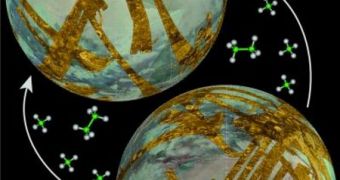Astronomical investigations of Saturn's moon Titan have revealed over the past few years that the celestial body has numerous methane and ethane lakes adorning its surface. As more and more data sets on the lakes were made available through observations by the Cassini spacecraft and other instruments, researchers noted a peculiarity on the moon, namely the fact that its lakes were unevenly distributed across its northern and southern region. Now, experts at the California Institute of Technology (Caltech) believe that they may have figured out why.
The team proposes that the distribution may have been caused by the eccentricity of Saturn's orbit around the Sun. The scientists argue that, when the same thing happens on Earth, the climate gets triggered into ice ages as well. The process has been dubbed “astronomical forcing.” The study group is led by expert Oded Aharonson, a Caltech associate professor of planetary science. The scientist is also the lead author of a new paper detailing the idea, which appears in the November 29 advance online edition of the respected journal Nature Geoscience.
According to data collected by Cassini's Synthetic Aperture Radar (SAR), the northern lakes on Titan cover more than 20 times the surface that lakes in the southern hemisphere do. The team says that the detected asymmetry is not a statistical fluke, and bases its assumption on the massive volume of data that was collected by the space probe over the past five years, since it has been observing the gas giant and its moons. Aharonson and his team first thought that, “There is something inherently different about the northern polar region versus the south in terms of topography, such that liquid rains, drains, or infiltrates the ground more in one hemisphere.”
In the journal entry, he says that the group could not find any proof that this was the case. One possible explanation could have been the fact that seasonal change affected the distribution of methane and ethane across the poles. Seeing how one year on Titan lasts 29.5 Earth years, this could have made sense. But the experts were not convinced.
“How do you move the hole in the ground? The seasonal mechanism may be responsible for part of the global transport of liquid methane, but it's not the whole story,” Aharonson says. “We propose that, in this orbital configuration, the difference between evaporation and precipitation is not equal in opposite seasons, which means there is a net transport of methane from south to north.”
“Like Earth, Titan has tens-of-thousands-of-year variations in climate driven by orbital motions. On Titan, there are long-term climate cycles in the global movement of methane that make lakes and carve lake basins. In both cases we find a record of the process embedded in the geology. We may have found an example of present-day climate change, analogous to Milankovitch climate cycles on Earth, on another object in the solar system,” the expert concludes.

 14 DAY TRIAL //
14 DAY TRIAL //